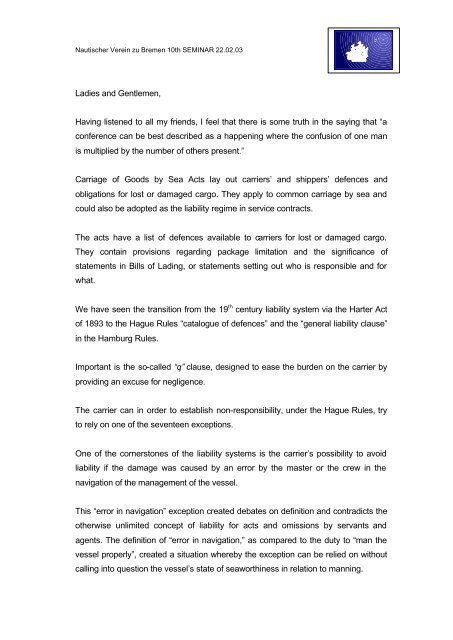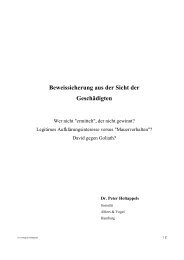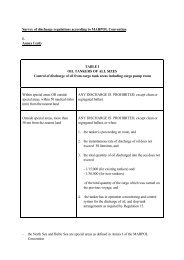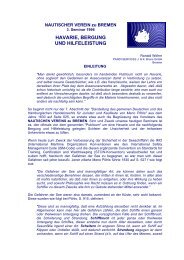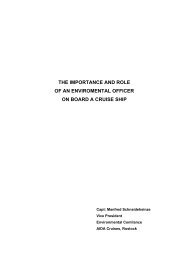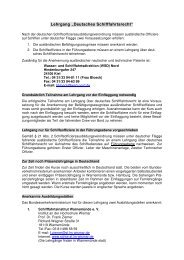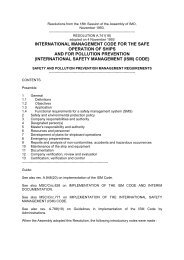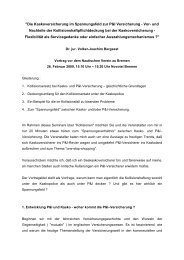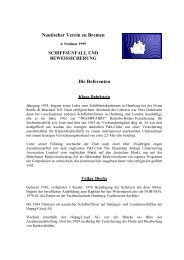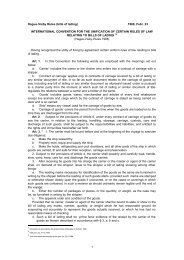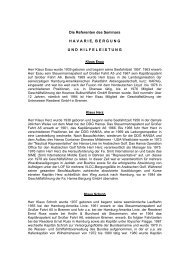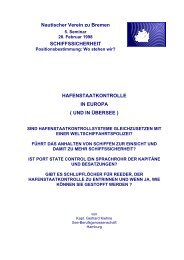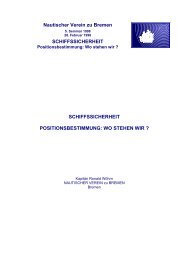10 LUEDDEKE Carrier defences - Nautischer Verein zu Bremen ...
10 LUEDDEKE Carrier defences - Nautischer Verein zu Bremen ...
10 LUEDDEKE Carrier defences - Nautischer Verein zu Bremen ...
Create successful ePaper yourself
Turn your PDF publications into a flip-book with our unique Google optimized e-Paper software.
<strong>Nautischer</strong> <strong>Verein</strong> <strong>zu</strong> <strong>Bremen</strong> <strong>10</strong>th SEMINAR 22.02.03<br />
Ladies and Gentlemen,<br />
Having listened to all my friends, I feel that there is some truth in the saying that “a<br />
conference can be best described as a happening where the confusion of one man<br />
is multiplied by the number of others present.”<br />
Carriage of Goods by Sea Acts lay out carriers’ and shippers’ <strong>defences</strong> and<br />
obligations for lost or damaged cargo. They apply to common carriage by sea and<br />
could also be adopted as the liability regime in service contracts.<br />
The acts have a list of <strong>defences</strong> available to carriers for lost or damaged cargo.<br />
They contain provisions regarding package limitation and the significance of<br />
statements in Bills of Lading, or statements setting out who is responsible and for<br />
what.<br />
We have seen the transition from the 19 th century liability system via the Harter Act<br />
of 1893 to the Hague Rules “catalogue of <strong>defences</strong>” and the “general liability clause”<br />
in the Hamburg Rules.<br />
Important is the so-called “q” clause, designed to ease the burden on the carrier by<br />
providing an excuse for negligence.<br />
The carrier can in order to establish non-responsibility, under the Hague Rules, try<br />
to rely on one of the seventeen exceptions.<br />
One of the cornerstones of the liability systems is the carrier’s possibility to avoid<br />
liability if the damage was caused by an error by the master or the crew in the<br />
navigation of the management of the vessel.<br />
This “error in navigation” exception created debates on definition and contradicts the<br />
otherwise unlimited concept of liability for acts and omissions by servants and<br />
agents. The definition of “error in navigation,” as compared to the duty to “man the<br />
vessel properly”, created a situation whereby the exception can be relied on without<br />
calling into question the vessel’s state of seaworthiness in relation to manning.
The ship-owner is liable as a carrier, provided there is no demise charter of the ship.<br />
I will refer further down to the JORDAN II, a case that recently decided that it was<br />
the charterer who was liable for cargo claims.<br />
Exception for fire damage<br />
The carrier can escape liability if he proves that the damage was caused by fire.<br />
The Hague Rules stipulate, however, that the fire damage exception is only valid if<br />
the carrier is not responsible for the fire. I will discuss this further down in the<br />
“EURASIAN DREAM”.<br />
The fire exception operates similar as one for acts and omissions by servants and<br />
agents. The rational for this privilege is because many fires on board of a ship are<br />
caused by the goods and the cause of the fire cannot easily be determined.<br />
One example is the obligation in respect of “peril of the sea”. The words used<br />
include the terms “peril of the sea” and “seaworthiness” and the obligation to prove<br />
that the vessel has satisfied the requirements requested for by the prevailing sea<br />
and weather conditions.<br />
It is suggested that it is required to prove that the vessel was seaworthy as a<br />
precondition if one wants to rely on a defence.<br />
Defences in case of damage<br />
Together with the two exceptions for acts and omissions by servants and agents<br />
(error in navigation and fire), the Hague Rules list other <strong>defences</strong>. These can be<br />
divided into four main categories:<br />
• irresistible and unpredictable forces<br />
• causes attributable to the cargo<br />
• attempts to save live; and<br />
• latent and hidden defects in the vessel.<br />
We now shall turn to some recent case law.<br />
Captain C. F. Lüddeke, Zürich - The <strong>Carrier</strong>’s Defences - 31/01/2003 2
There is a rather interesting case that will interest insurers and recovery agents alike<br />
concerning a Bill of lading and the agent's failure to present 1 .<br />
The Underwriters of the shippers sought to recover from agents in Georgia in<br />
respect of a settlement made by the Claimant with cargo underwriters. The dispute<br />
concerned two shipments of butter under the Claimant's bill of lading in March 1999.<br />
There was a long sale chain. The Defendant did not hand over the goods to the endconsignee<br />
against delivery of an original bill of lading, but handed them over to<br />
earlier consignees, although the goods did reach the intended recipients at the end<br />
of the contractual chain. The shipper was not paid by the receiver until June 1999. In<br />
the meantime, cargo underwriters made payments to the shippers under the<br />
insurance policy and the Claimant settled with underwriters in respect of this. The<br />
Claimant claimed for breach of the agency agreement in releasing the cargo without<br />
presentation of the original bill of lading, alternatively under an indemnity in the<br />
agreement.<br />
It was held that the Claimant's settlement with cargo underwriters was not<br />
reasonable in all the circumstances as their investigation of the claim was narrow<br />
and superficial. There was a lack of evidence, which made establishing the scope of<br />
the claim difficult. It was extremely unlikely that underwriters would have paid, let<br />
alone have paid as quickly as they did, had they been informed that the goods had<br />
reached the intended buyers, that there was no question of the bills of lading being<br />
used as security für payment of the goods and that the shippers had been paid. Had<br />
the claim been competently handled, the Claimant would have discovered that the<br />
shippers had been paid. Legal advice would have been obtained and the claim<br />
would have been competently tested. Once the relevant facts had been discovered,<br />
the claim against the Claimant would probably not have been pursued on any basis.<br />
The Claimant was entitled to nominal damages only.<br />
In the "Bunga Seroja"<br />
The Admiralty Division of the Supreme Court of New South Wales handed down an<br />
important decision in connection with the interpretation of the perils of the sea<br />
defence under the Hague Rules.<br />
1 P&O Nedlloyd Ltd (2) P&O Nedlloyd BV v M&M Militzer & Munich International Holding AG<br />
Captain C. F. Lüddeke, Zürich - The <strong>Carrier</strong>’s Defences - 31/01/2003 3
The Bunga Seroja, owned by Malaysian International Shipping Corporation (MISC),<br />
was carrying a cargo of aluminium coils in ten containers from Sydney to Keelung.<br />
While transiting the Bass Strait, she encountered severe storm conditions and<br />
suffered structural damage. On discharge, a number of coils were found to have<br />
been damaged due to shifting within the containers as a result of the heavy weather.<br />
A claim was brought by the cargo owners. The trial judge found that the carrier had<br />
discharged its responsibilities under Article 3 Rule 2 of the Hague Rules to "carefully<br />
to carry and care for the cargo". No question therefore arose as to whether the loss<br />
or damage had occurred as a result of the carrier not having exercised due diligence<br />
to make the ship seaworthy (Article 4, Rule 1). Nor had the loss or damage resulted<br />
from any negligence by the carrier, master or crew in the management of the vessel<br />
(Article 4 Rule 2a) or from perils of the sea (Article 4 Rule 2c).<br />
Rejecting the stricter US and Canadian approach, which take into account the<br />
element of foreseeability, the High Court continued to favour the Anglo-Australian<br />
approach in holding that MISC could still have relied on the perils of the sea<br />
defence, even though the weather encountered was foreseeable and had in fact<br />
been foreseen as the vessel had received forecasts of heavy weather that it would<br />
meet on the crossing.<br />
The Australian High Court continued to favour the more lenient approach to the use<br />
of the perils of the sea defence because otherwise it would transform the obligation<br />
to use due diligence to make the vessel seaworthy into an absolute obligation of<br />
seaworthiness which, the court felt, would deny the history of the development of<br />
this defence and its place in the context of the Hague Rules as a whole.<br />
Due diligence<br />
The Supreme Court of Western Australia handed down a ruling in a general average<br />
dispute which highlights the need for ship-owners to observe proper maintenance<br />
procedures and to properly document all maintenance work performed. 2<br />
The case arose from the failure of a nut which formed part of the engine on the<br />
2 Andre Toulemonde Wool Co Pty Ltd v Knutsen Offshore (Panama) SA<br />
Captain C. F. Lüddeke, Zürich - The <strong>Carrier</strong>’s Defences - 31/01/2003 4
cargo ship HANNE BAKKE. Eleven hours into a voyage from Fremantle to Hong<br />
Kong, the vessel's engine stopped and could not be restarted. One of the twelve<br />
cylinder shafts had been ripped apart, resulting in severe damage to the engine. The<br />
ship was towed back to Fremantle, where repairs were carried out.<br />
As a result of the incident, delivery of the vessel's cargo was delayed. The ship<br />
owner made a claim for general average contribution against the owners of the<br />
cargo.<br />
The case turned on whether the ship owner had exercised due diligence with<br />
respect to that crucial nut which formed part of the cylinder assembly of the ship's<br />
engine. The owner argued that there was a latent defect in the cylinder which it was<br />
impossible to discover. It maintained that the nut was not involved. The cargo<br />
interests, meanwhile, maintained that the engine failure was due to the failure to<br />
tighten the nut which formed part of the cylinder. They said there was a failure to<br />
conduct a proper general maintenance regime. The issue was important because<br />
the entitlement to general average contribution was dependent on the carrier's<br />
exercise of due diligence.<br />
After hearing expert evidence from marine engineers, and from those charged with<br />
carrying out maintenance on the vessel's machinery, the court concluded that, not<br />
only was the ship unseaworthy when it left Fremantle, but the unseaworthiness was<br />
due to a want of due diligence on the part of the ship-owner. Accordingly, the owner<br />
could not make a claim for general average contribution from the cargo interests.<br />
The JORDAN II<br />
The owner of the Jordan II was found not liable for a steel cargo damaged by poor<br />
handling and carriage. Deciding that the charter party had transferred full<br />
responsibility to the Charterer, a London judge also reaffirmed the Pyrene v Scindia<br />
principle that the "proper performance" obligations under the Hague-Visby Rules<br />
only apply to functions the carrier has agreed to carry out.<br />
Deciding that neither the voyage charterer of the Jordan II, nor the shipper and<br />
receiver of its cargo of steel coils can sue the owner for alleged damage in transit,<br />
deputy judge Nigel Teare QC rejected a claim that the interpretation of Article III rule<br />
2 of the Hague (later Hague-Visby) Rules, dating from the 1954 Pyrene v. Scindia<br />
case, was "wrong".<br />
Captain C. F. Lüddeke, Zürich - The <strong>Carrier</strong>’s Defences - 31/01/2003 5
What had the parties actually agreed in the charter and the bills of lading? And was<br />
this overridden by the Hague-Visby requirements as to the carrier’s obligations?<br />
The Jordan II was voyage chartered in December 1997, to carry 5,500 tonnes of<br />
galvanised steel coils from India to Spain. Under clause 3, of the charter freight was<br />
to be paid per metric ton FIOST [free in and out, stowed and trimmed] –<br />
lashed/secured/dunnaged.<br />
Clause 7 read: "Charterers to have full use of all vessel’s gear to assist in loading<br />
and discharging," but this was only to be "supplementary to the shore gear", shore<br />
winch men and crane men "to be used at all times".<br />
Clause 17 read: "Shipper/Charterers/Receiver to put the cargo on board, trim and<br />
discharge cargo free of expense to the vessel," trimming being described as<br />
"levelling off the top of the pile". The charter was subject to English law, and<br />
incorporated Hague-Visby.<br />
The shipper, Jindal Iron, the receiver, Hiansa, and TCI as charterer, complained that<br />
the cargo was damaged, and started proceedings against Islamic Solidarity. TCI<br />
sued under the charter, Jindal and Hiansa as bill of lading holders. Islamic Solidarity<br />
responded that, as ship owner, it was not liable for the cargo operations, either<br />
under the charter or under the contracts of carriage evidenced by the bills of lading.<br />
The claimants’ case was that even if clause 3 required the charterer to pay for<br />
loading, stowing, this did not transfer responsibility for ‘proper performance’. Islamic<br />
countered by arguing that clauses 3 and 17 transferred both obligations – to pay,<br />
and to ensure the operations were properly carried out.<br />
Mr Teare QC, the deputy judge said the owner had a responsibility for ‘proper<br />
performance’ under common law, and if this was to be transferred to the charterer,<br />
the charter party must use "clear words". Clause 3, would not, by itself, have been<br />
enough to transfer this responsibility.<br />
Clause 3 was a freight clause and, while it transferred liability for the expense of<br />
cargo operations, it did not "clearly" transfer the duty to perform them properly.<br />
However, it would have to be read with clause 17, which could be understood as<br />
Captain C. F. Lüddeke, Zürich - The <strong>Carrier</strong>’s Defences - 31/01/2003 6
including the FIOST requirements. Steel coils did not need ‘trimming’ but did require<br />
the services of lashing, securing and dunnage specified in clause 3.<br />
"Bearing that in mind," said the judge, "that the obligation to trim in clause 17 was<br />
intended by the parties to mean the obligation to lash, secure and dunnage." These<br />
responsibilities, he ruled, were transferred from the owner to TCI, the charterer, who<br />
therefore could not claim damages.<br />
Rejecting arguments that the reference to trimming was too "ambiguous" to transfer<br />
responsibility, and was "commercially repugnant to the bill of lading" because it<br />
removed the carrier’s normal responsibilities, he went on to hold that when cl 3 and<br />
17 were read into the bills of lading, they must be read together in the same way.<br />
The ‘trimming’ reference in cl 17 should "clearly be understood" in the same sense<br />
as in cl 3. The shipper and receiver could not claim under the bills of lading unless<br />
they could prove the damage was the ship owner’s fault.<br />
Mr Teare QC ruled that the clauses were not invalid under Article III, rules 2 and 8 of<br />
the Hague-Visby Rules, which says the carrier is responsible under the bills of<br />
lading for poor loading, stowage and discharge. He declined to reject the Pyrene<br />
versus Scindia view, subsequently confirmed by the House of Lords, that the<br />
carrier’s obligation to load, stow, carry and discharge the goods ‘properly and<br />
carefully’ only applied if he had agreed to carry out those functions.<br />
The “SAINT JACQUES II 3<br />
This case is believed to be the first in England where a party's ability to limit its<br />
liability under the 1976 Limitation Convention was held potentially open to<br />
successful challenge. It also illustrates just how difficult it will be in most cases to<br />
"break" that limitation.<br />
At about 4.30 am on 23rd April 2001, the fishing vessel, "Saint Jacques II", owned<br />
and skippered by Mr Margolle, collided with the "Gudermes", a motor tanker owned<br />
by Delta Maritime. Delta Maritime and the cargo owners immediately issued<br />
3<br />
Loic Ludovic Margolle and another v Delta Maritime Company Limited and others -English Admiralty<br />
Court: Gross j.: 28 November 2002 Nicholas Saunders, instructed by Constant & Constant, for<br />
Margolle Elizabeth Blackburn Q.C., instructed by Richards Butler, for Delta Maritime collision: limitation<br />
of liability: reckless navigation: whether owners had relevant knowledge that loss would probably result<br />
Captain C. F. Lüddeke, Zürich - The <strong>Carrier</strong>’s Defences - 31/01/2003 7
proceedings for damages in the region of US$700,000. In August 2001, Mr Margolle<br />
began these proceedings under the Merchant Shipping Act 1995 seeking a decree<br />
under the 1976 Limitation Convention limiting any liability he might have for<br />
damages.<br />
The dispute centred on Article 4 of the Convention, which provides:<br />
"Conduct barring limitation”.<br />
“A person liable shall not be entitled to limit his liability if it is proved that the<br />
loss resulted from his personal act or omission, committed with the intent to<br />
cause such loss, or recklessly and with knowledge that such loss would<br />
probably result."<br />
There was no suggestion that the collision was caused intentionally, but Delta<br />
Maritime alleged it was caused by the personal act or omission of Mr Margolle<br />
committed recklessly and with knowledge that such loss would probably result.<br />
Mr Margolle’s lawyers applied for summary judgment, on the basis that Delta<br />
Maritime had no real prospect of successfully contesting the limitation claim and<br />
there was no other compelling reason why the claim should go to trial. The Admiralty<br />
Registrar dismissed the application. The Registrar reached his conclusion believing<br />
Mr Margolle was on the bridge at the time of the collision. New evidence, however,<br />
confirmed that he was, in fact, asleep below. Mr Margolle appealed.<br />
The collision took place as the Saint Jacques II, skippered by Mr Margolle, was<br />
sailing from Boulogne towards the Falls Bank fishing grounds. In his haste to get<br />
there before his competitors, Mr Margolle set a course across the South West Traffic<br />
Lane of the Dover Straits Traffic Separation Scheme, heading against the flow of<br />
traffic, in contravention of Rule <strong>10</strong> of the Convention on the International<br />
Regulations for Preventing Collisions at Sea 1972. This, as Mr Justice Gross put it,<br />
was the "nautical equivalent of a motorist proceeding the wrong way along a<br />
motorway".<br />
Although Mr Margolle had determined the course to be steered, he was down below<br />
when the collision took place, having left the vessel in charge of a 17-year old<br />
deckhand. Mr Margolle argued that the navigation of the vessel in the final minutes<br />
before the collision could not be the result of his personal act, because he was<br />
asleep at the time.<br />
Captain C. F. Lüddeke, Zürich - The <strong>Carrier</strong>’s Defences - 31/01/2003 8
This was not the first time the Saint Jacques II had breached the Collision<br />
Regulations. Delta Maritime had evidence of five other instances of rogue<br />
navigation. Mr Margolle, however, argued that because he had "got away with it" so<br />
many times in the past, one could not infer from that that he was reckless or had<br />
knowledge that damage would result, as required by Article 4.<br />
The burden of proof under the Limitation Convention rests with the party seeking to<br />
"break" the limit. That burden is a very heavy one. Where there is no allegation of<br />
intent, the party challenging the limitation must establish reckless conduct and<br />
knowledge that the loss would probably result.<br />
When a person acts recklessly, he acts in a manner which indicates a decision to<br />
run the risk or a mental attitude of indifference to its existence. 4 The knowledge<br />
required is actual, not constructive, in the sense of appreciation or awareness at the<br />
time of the conduct in question, that it will probably result in the type of damage<br />
caused. Nothing less will do. 5<br />
But the test under the 76 Limitation Convention is even higher than the test under<br />
Warsaw. It requires a personal act or omission of the party seeking to limit, rather<br />
than the act or omission of the carrier his servants or agents. In addition, under<br />
Warsaw, the relevant knowledge is that damage would probably result but, under<br />
the 76 Limitation Conventions, the relevant knowledge under Article 4 is that "such<br />
loss" would probably result.<br />
Lord Phillips said that "such loss requires foresight of the very loss that actually<br />
occurs, not merely of the type of loss that occurs". 6 In a collision between Ship A<br />
and Ship B, therefore, the owners of Ship A would only defeat the owner of Ship B's<br />
right to limit liability if they could prove that he intended that Ship B should collide<br />
with Ship A or acted recklessly with the knowledge that it was likely to do so.<br />
This was just such a case. If one looked only at the last minutes of navigation before<br />
the collision, Mr Margolle could not have had any personal involvement in the<br />
navigation during those minutes because he was asleep at the time. Had the case<br />
rested on this alone, Mr Margolle would have been able to limit his liability.<br />
4 Goldman v Thai Airways Limited [1983] 1 WLR 1186<br />
5 Nugent v Goss Aviation [2000] 2 Lloyd's Rep 222<br />
6 Schiffahrtsgesellschaft MS Merkur Sky MBH & Co v MS Leerort Schiffahrts Gmbh &Co KG [2001] 2<br />
Lloyd's Rep 291<br />
Captain C. F. Lüddeke, Zürich - The <strong>Carrier</strong>’s Defences - 31/01/2003 9
But the decisive factor was the evidence that this was not the first time the Saint<br />
Jacques II had been navigated across the traffic lane on Mr Margolle's instructions.<br />
This appalling navigational practice, combined with the obvious risk of collision, left it<br />
open to the court at trial to infer that Mr Margolle had the relevant actual knowledge<br />
that a collision would probably result, whether with the Gudermes or with some other<br />
vessel.<br />
The fact that Mr Margolle had got away with this sort of behaviour in the past made<br />
no difference, since there is nothing to suggest that the risk or probability of a<br />
collision diminishes with repeated reckless navigation. If anything it increases. In<br />
any event, the test was the subjective knowledge of Mr Margolle, not an objective or<br />
logical analysis of risk.<br />
As a result, the judge was satisfied that Delta Maritime had a real prospect of<br />
demonstrating at trial that Article 4 of the Limitation Convention applied. Mr<br />
Margolle's application for summary judgment was dismissed.<br />
An interesting case is that of the MSC ROSA M 7<br />
Under Article 4 the burden of proof lies on cargo interests to show that limitation of<br />
liability should not apply on the ground that "the loss resulted from his personal act<br />
or omission, committed with the intent to cause such loss, or recklessly and with<br />
knowledge that such loss would probably result." Cargo interests claimed that on the<br />
facts there were various defects in the fuel and ballast systems which endangered<br />
the vessel, and that the Captain knew about some of these defects, and that he<br />
ought to have known about other defects if the ship's reporting procedures were not<br />
deficient. The failure of the Captain to take the appropriate actions with regard to the<br />
defects was argued to constitute a reckless disregard for the safety of the ship,<br />
which the Captain should have known would lead to a serious incident.<br />
The purpose of the 1976 Convention is to give a higher limit in return for an almost<br />
indisputable right to limit Owners liability. There were no examples in English<br />
maritime law of a successful defence to limitation based on Article 4. If there was no<br />
7 MSC Mediterranean Shipping Co SA -v- Delumar & Ors, The 'MSC Rosa M' 13.07.2000 Limitation<br />
Action - Article 4 of Convention on Limitation for Maritime Claims 1976 - should Owners be precluded<br />
from obtaining decree of limitation - Held: the onerous burden of Article 4 had not been met - decree of<br />
limitation applied. Q. B. Division, David Steel J.<br />
Captain C. F. Lüddeke, Zürich - The <strong>Carrier</strong>’s Defences - 31/01/2003 <strong>10</strong>
intent, then cargo interest has to show both:<br />
(1) reckless conduct<br />
and;<br />
(2) knowledge<br />
that the type of loss in question would result. On the facts, cargo interests’ case<br />
disclosed no reasonable ground to challenge limitation.<br />
The chances of breaking limitation are very slim. It is not enough that the Master is<br />
or should have been aware of the defects. It is the conduct and knowledge of the<br />
person seeking to limit which is important.<br />
The dangers of wrong, superfluous instructions or off-the-shelf ISM systems copied<br />
from reports by eager claims managers who probably do not understand what they<br />
read, are best demonstrated in the following case.<br />
Since ISM, speculations are made as to what impact the implementation of the code<br />
would have on judicial determination relating to issues of seaworthiness. The recent<br />
High Court judgment of the “EURASIAN DREAM” that turned into the EURASIAN<br />
NIGHTMARE provided some insight into this matter.<br />
In July 1998, the car carrier EURASIAN DREAM became a constructive total loss<br />
and the entire cargo was destroyed after the crew was unable to contain a fire which<br />
originated in a vehicle aboard the vessel. At the time of the loss, there was no<br />
mandatory requirement for the vessel to be ISM certificated.<br />
The court found that the managers had an ISM system in place providing the vessel<br />
with the same safety manuals as other vessels in their fleet.<br />
The issue before the court was that of liability for the cargo. The carrier had provided<br />
that the Bill of Lading contracts incorporated both the Hague and the Hague-Visby<br />
Rules. Article III of both the rules, require the carrier to exercise due diligence before<br />
and at the commencement of the voyage to provide a seaworthy vessel. The vessel<br />
must be properly manned, equipped and supplied with cargo compartments, fit and<br />
safe for the reception, carriage and preservation of cargo. The court found that<br />
unseaworthiness was causative of the cargo loss for which the owners of the<br />
Eurasian Dream were liable. The vessel was unseaworthy by reason of the<br />
condition of the vessel's equipment and the lack of competency and efficiency of the<br />
Captain C. F. Lüddeke, Zürich - The <strong>Carrier</strong>’s Defences - 31/01/2003 11
master, crew and the inadequacy of the documentation supplied to the vessel. The<br />
court acknowledged that the vessel's equipment complied with Solas regulations. It<br />
is clear, however, that mere compliance with Solas regulations may be insufficient<br />
for the purposes of establishing seaworthiness. This suggests that it is incumbent on<br />
the manager and owner to perform a risk assessment to determine safety<br />
equipment requirements, having regard to the vessel’s type, nature of the cargo and<br />
trade, rather than merely relying on compliance with Solas regulations.<br />
The master of the Eurasian Dream would have required two to three weeks to read<br />
all manuals. The managers were found at fault for not providing a briefing letter<br />
targeted at the vessel type and the master's experience. Such a letter should have<br />
summarised the guidance to be given to a master in relation to emergency<br />
procedures and have would directed him to the relevant parts of the manuals. The<br />
court said that there was too much documentation; much of it was irrelevant and<br />
obsolete often referring to other vessel types and concluded, for efficiency and<br />
competence of response, only one code or set of procedures should have been<br />
prescribed for the master.<br />
Those masters who have been expected to familiarise themselves with a new safety<br />
management system on joining a vessel will take comfort that the court found the<br />
Eurasian Dream's documentation too voluminous to be digestible and that a<br />
manager does not discharge his responsibility by simply instructing the master to<br />
read the manuals and instructions onboard. The ISM Code is an integral part of the<br />
standards and practices of the industry. It appears likely that in any future dispute<br />
over seaworthiness, managers and owners should be prepared that implementation<br />
and effectiveness of their ISM systems will be closely scrutinized. One should also<br />
take note that mere compliance with Solas regulations regarding equipment onboard<br />
is not sufficient for the purposes of establishing seaworthiness. Finally, the case of<br />
the Eurasian Dream should serve as a warning to those managers that have<br />
purchased an, 'off the shelf' ISM system. The courts will examine the adequacy,<br />
relevance, size and 'user friendliness' of the manuals as well as the method by<br />
which key personnel are familiarised with the system.<br />
Ladies and gentlemen you will be pleased to hear that I have come to the end of my<br />
discussion I do presume that confusion reigns supreme. It is rather important for<br />
persons handling cargo claims to know the difference between Hague-Visby and<br />
what some conceived to be the name “Haig Whiskey”. One of my successors in<br />
MSC is of that specie.<br />
Captain C. F. Lüddeke, Zürich - The <strong>Carrier</strong>’s Defences - 31/01/2003 12
Please do always remember, that<br />
Defences in court actions look bigger when entering the court<br />
but much less so when leaving.<br />
Captain C. F. Lüddeke, Zürich - The <strong>Carrier</strong>’s Defences - 31/01/2003 13
Captain Christof F. Lüddeke, FNI<br />
Captain Christof F. Lüddeke, FNI has been<br />
director of MSC Mediterranean Shipping Co.<br />
SA, a shipping company in Geneva<br />
Switzerland, for 30 years and was in charge<br />
of the insurance, claims and legal<br />
department. He has been at sea for 20 years,<br />
commencing his seafaring career as cadet on<br />
the square-rigger "PASSAT". He is Master<br />
Mariner and Lt. Cdr. of the German Naval<br />
Reserve. Fellow of the Nautical Institute.<br />
Brother of the Schiffer-Gesellschaft <strong>zu</strong> Lübeck, Germany. Member of the Society of<br />
Master Mariners of South Africa and the Hon. Company of Master Mariners,<br />
London. Member of the International Federation of Shipmasters. Member of the<br />
Friends of the square-riggers Pamir & Passat. Member of the Technical Advisory<br />
Group of the Germanischer Lloyd classification, Hamburg. He was director on the<br />
Board of the North of England P&I Association Ltd. He is director on the board of<br />
Shoreline, an international maritime pollution COFR organisation. Member of the<br />
Swiss Maritime Law Association. Acting as arbitrator as full member of the German<br />
and the Mediterranean Maritime Arbitrators Association, of the Chambre Arbitrale<br />
Maritime de Monaco. He opened a trustfund with the Nautical Institute in London.<br />
This fund has been built up with the royalties received for the various publications<br />
and hands out an annual prize for the best student of the year in the Institute's<br />
"Command" scheme.<br />
Lüddeke is Member of the Deutsche Gesellschaft für Transportrecht e.V. He was<br />
closely involved with the development of Slot Charter Parties and "Standard Service<br />
Contracts" as member of BIMCO working Groups and is Swiss member of the IMLA<br />
working group on International Transport Law.<br />
He is author of a textbook on the<br />
Hamburg Rules and the "Guide to<br />
Marine Claims", both published by<br />
Lloyd's of London Press Ltd., co-author<br />
of books on "The Management of<br />
Safety in Shipping" and "Command"<br />
published by the Nautical Institute. He<br />
published articles about maritime law<br />
and insurance with Kluwer Law, Cargo<br />
Claim Analysis, Charterparty International, P&I International and others. He was<br />
frequently appointed maritime expert by the Lausanne Commercial Court. Speaker<br />
at seminars, published various articles in maritime newspapers.<br />
Since his departure from MSC Mediterranean Shipping Co. SA Geneva, he works<br />
as Maritime Consultant in Zurich and as Correspondent for the P&I Clubs:<br />
Transmarine, London, Michael Else and Co. Ltd., London, North of England P&I<br />
Assoc. Ltd., Newcastle upon Tyne, The Standard Steamship Owners' Protection<br />
and Indemnity Association, Bermuda & London, The Charterers P&I Club, London<br />
Swiss agent for: MacDonald Hebditch & Co. Ltd. General Average Adjusters,<br />
England, C.E. Goltermann Succrs. Schiffahrts- und Handelsgesellschaft mbH,<br />
Hamburg, Mountbatten Finance Ltd. London.<br />
General Representative of the North of England Insurance Co. accredited by the<br />
Bundesamt für Privatversicherungen.<br />
Captain C. F. Lüddeke, Zürich - The <strong>Carrier</strong>’s Defences - 31/01/2003 14


